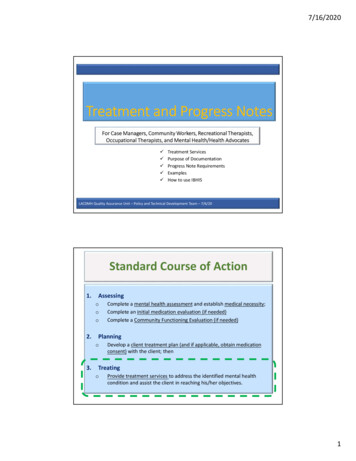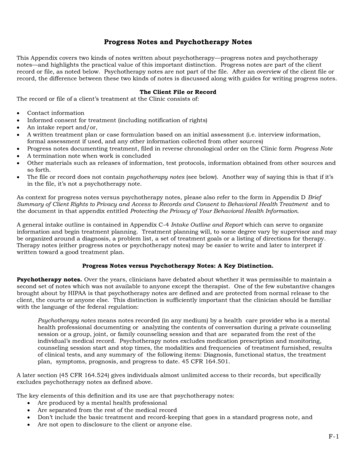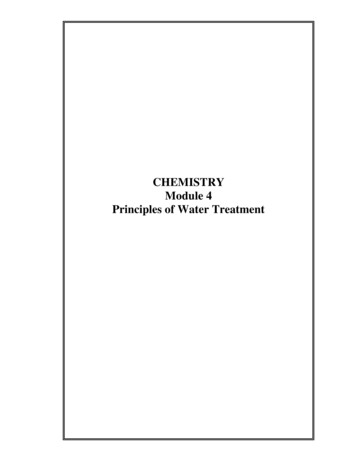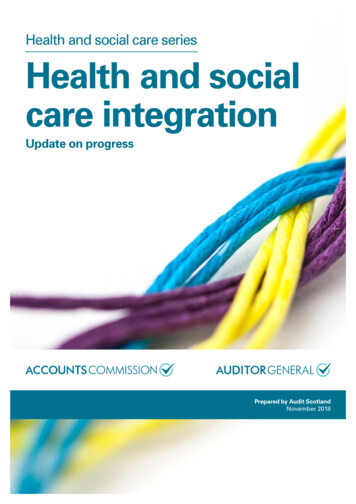
Transcription
7/16/2020Treatment and Progress NotesFor Case Managers, Community Workers, Recreational Therapists,Occupational Therapists, and Mental Health/Health Advocates Treatment ServicesPurpose of DocumentationProgress Note RequirementsExamplesHow to use IBHISLACDMH Quality Assurance Unit – Policy and Technical Development Team – 7/6/20Standard Course of Action1.Assessingooo2.Planningo3.Complete a mental health assessment and establish medical necessity;Complete an initial medication evaluation (if needed)Complete a Community Functioning Evaluation (if needed)Develop a client treatment plan (and if applicable, obtain medicationconsent) with the client; thenTreatingoProvide treatment services to address the identified mental healthcondition and assist the client in reaching his/her objectives.1
7/16/2020What are TreatmentServices?Treatment ServicesTreatment Services services that address a client’s mentalhealth needs and are not primarily for the purpose of:ooooAssessmentPlan DevelopmentCrisis InterventionLinkage and referral if a need of immediate concern exists Documented inthe client’sTreatment Plan Provided to theclient or thesignificantsupport person Providedindividually or in agroup/familysetting Provided inperson, over thephone, or viatelehealthFor more information, refer to the Organizational Providers Manual2
7/16/2020Treatment ServicesFor treatment services to be reimbursable by Medi-Cal, theinterventions described must: Represent a covered SpecialtyMental Health Service (servicecomponent)Mental HealthServices (MHS) Reduce the client’s impairment,restore his/her functioning, orprevent significant deterioration inthe client’s functioning Be on the client’s treatment planAssessmentPlan DevelopmentTherapyRehabilitationCollateralBe individualized to the client’sspecific needs and relate to theclient’s diagnosis and impairmentsFor more information, refer to the Organizational Providers Manual and QA Bulletin 17-13Outpatient SMHS covered & provided by directly-operated(reimbursable services)Mental HealthServices (MHS)Individual, group, collateral or family-based interventions to restore aclient’s functioning and ability to remain in the community with goals ofrecovery and resiliencyIntensive HomeBased Services(IHBS)An intensive form of MHS that is predominantly delivered in the home,school or community. IHBS is specifically intended for children/youth whoare already receiving Intensive Care Coordination.Targeted CaseManagement(TCM)Services that assist a client in accessing needed ancillary resources (e.g.medical, alcohol/drug treatment, vocational)Intensive CareCoordination(ICC)An intensive form of TCM that facilitates the assessment, planning andcoordination of services. ICC is specifically intended for children/youth whoare involved in multiple child serving systems and require cross-agencycollaboration through a Child and Family TeamMedicationSupport Services(MSS)Prescribing/furnishing, administering and monitoring psychiatricmedications to reduce a client’s mental health symptomsCrisisIntervention (CI)Unplanned and expedited services to address a condition that requiresmore timely response than a regular appointment in order to assist a clientto regain/remain functioning in the community. AssessmentPlan DevelopmentTherapyRehabilitationCollateral Rehabilitation Collateral AssessmentPlan DevelopmentReferral and Related ActivitiesMonitoring & Follow-Up Planning & Assessment of Strengths &Needs Reassessment of Strengths & Needs Referral, Monitoring, and Follow-UpActivities Transition Evaluation of the Need for Meds Evaluation of Clinical Effectiveness &Side Effects of Meds Obtaining Information Consent Medication Education Collateral Plan Development AssessmentTherapyCollateralReferral3
7/16/2020MHS Treatment ServicesServiceComponentProcedureCode(s)What the Service EntailsCollateral90887A service provided to a significant support person* which caninclude: consultation and training of the mental health diagnosis andimpairments teaching skills to better assist the client at home or in thecommunity*Examples of significant support persons include family members andclose relatives, foster parents, friends, teachers, DCFS social workers,public guardian, etc.RehabilitationH2015Restoring, improving, and/or preserving a client’s functional,social, communication, or daily living skills to enhance selfsufficiency or self-regulation.Emotional, social, and intellectual skill-building to live and workin the community with the least amount of professionalsupport.Procedure Code Modifiers SC – for services provided over thetelephone GT – for services provided viatelehealthIHBS Treatment H2015HKWhat the Service EntailsA service provided to a significant support person* which caninclude: consultation and training of the mental health diagnosis andimpairments teaching skills to better assist the client at home or in thecommunity*Examples of significant support persons include family members and closerelatives, foster parents, friends, teachers, DCFS social workers, publicguardian, etc.RehabilitationH2015HKRestoring, improving, and/or preserving a client’s functional,social, communication, or daily living skills to enhance selfsufficiency or self-regulation.Emotional, social, and intellectual skill-building to live and work inthe community with the least amount of professional support.These services are more intensive and arepredominantly delivered in the home, schoolor community. These services are alsospecifically intended for children/youth whoare already receiving ICC.Procedure Code Modifiers SC – for services providedover the telephone GT – for services providedvia telehealth4
7/16/2020TCM Treatment ServicesServiceComponentProcedureCodeWhat you didReferral &Related ActivitiesT1017A service that helps clients get access to neededancillary services (e.g. medical, alcohol and drugtreatment, social, educational providers, etc.) andincludes Making referrals and scheduling appointments Coordinating service and mobilizing resourcesMonitoring &Follow UpT1017A service that includes activities and contacts toensure that the client’s treatment plan isimplemented and that services are adequate andbeing providedProcedure Code Modifiers SC – for services provided over thetelephone GT – for services provided viatelehealthICC Treatment ServicesServiceComponentProcedureCodeWhat you didReferral,Monitoring, andFollow-UpActivitiesT1017HKEvaluating the effectiveness of the plan, assessingcircumstances and resources, and reworking the planas needed. Activities that ensure that thechild/youth’s needs are met including ensuring thatservices are being furnished in accordance with thechild/youth’s plan.TransitionT1017HKDeveloping a transition plan for a child/youth andfamily to foster long term stability including theeffective use of natural supports and communityresources.These services are specifically intended forchildren/youth who are involved in multiplechild serving systems and require crossagency collaboration through a CFT.Procedure Code Modifiers SC – for services providedover the telephone GT – for services providedvia telehealth5
7/16/2020Providing Treatment During a Medi-Cal LockoutMedi-Cal Lockout when Specialty Mental Health Services are not reimbursable by Medi-Cal(i.e. client is in an IMD, jail/prison setting, psychiatric inpatient/psychiatric health facility/crisisresidential facility, excluding the dates of admission and discharge) Also used by CalWorks/GROW programs using the CalWorks/GROW funding planWhat it isProcedure CodeMHS that are not billable to Medi-Cal due to reasons below but arebillable to another payer source: Medi-Cal Lockout Lack of medical necessityMHS00001TCM services that are not billable to Medi-Cal due to reasons belowbut are billable to another payer source: Medi-Cal Lockout Lack of medical necessityTCM00002For more information, refer to QA Bulletin 17-03Procedure Code ModifiersServices may be provided over thetelephone or telehealth, however,no modifier is utilized with thesecodes“Services” that are never billablePause thevideo if youwant to reviewthis list1.No shows and missed appointments2.Services solely for transportation3.Leaving the client a voicemail or text message4.“Linkage” to the program’s psychiatrist, NP, or other treatment team member5.Supervisory type activities6.Interpretation/translation (e.g. providing “cultural competent services”)7.“Check-Ins” with no identified purpose8.Getting up to date when cases are transferred to you9.10.11.Reviewing the chart with no identified service (e.g. checked to make sure everything is up todate, to schedule an appointment)Making copies of chart for release of recordsGeneral activities that help the clinic (e.g. buy food/items for groups, develop forms for clientsto complete)6
7/16/2020Scenarios when a billable service can be provided toa no-show or missed appointmentCase Manager reviews the last few progress notes in preparationfor today’s rehab session with a client. Client does not show up.Client calls to cancel today’s scheduled session due to feeling“overwhelmed.” Practitioner asks about this and prompts clientto use coping skills learned in sessions. Practitioner and clientcontinue to engage in a rehab session over the phone.Father calls practitioner to reschedule today’s family session.Father mentions feeling frustration as client recently had anincident at school. Practitioner and father discuss ways to addressclient’s behavior and modeled ways father can respond to client’snegative behaviors.90885Record ReviewH2015SCRehab(over the phone)90887SCCollateral(over the phone)In IBHIS – appointment will be marked as “no show” or “canceled by client,” and thebillable service will be documented using a Special Use Progress Note*Refer to the Scheduling Calendar ModuleTreatment ProcessBefore the treatmentsession with the client During the treatmentsession with the client (this can be in-person, overthe phone, via telehealth)After the treatmentsession Reviews Treatment Plan to determine what interventions will beprovided during the client’s sessionMay also review other documentation (e.g. last few progressnotes or medication notes)Practitioner and client: discuss any important updates since the last session review client’s progress or lack of progress update the plan, if applicablePractitioner provides intervention as described in the treatment planIf collaborative documentation is used, practitioner and client maywrite the progress note togetherMay fine tune the progress note and finalize the formClaims for the time spent providing the treatment service via theappropriate progress note form7
7/16/2020Documenting onProgress NotesProgress Note Services provided to clients are documented using aprogress note Within the progress note: Select the procedure code based on the service provided Enter the duration of the service Face to Face Time time spent seeing the client Other Time time spent providing a service to a significant support person time spent writing the progress note and completing otherapplicable forms travel time, if this applies8
7/16/2020Purpose of DocumentationClinical Care&Coordination of CareCommunicate the client’scondition, your treatment,and facilitate continuum ofcareClinical Record is aLegal DocumentReimbursementTo provide evidence ofwhat occurredSo payer knows whatthey are paying forProgress Note RequirementsPause thevideo if youwant to reviewthis list Date of service Procedure code Duration of service (face to face and other time) Relevant aspects of client care including medical necessity Relevant clinical decisions Interventions applied Client’s response to interventions Location of interventions If appropriate, referrals to community resources, follow up care Signature of the person providing servicesFrequency - a progress note is needed for every service contact for MHS, TCM*,IHBS, ICC, MSS, and Crisis Intervention*TCM progress note may include multiple service activities (e.g. phone calls) performed w/inthe same day and intended to accomplish the same specific objectiveReference: DMH Policy 401.03 and the Organizational Provider’s Manual9
7/16/2020What to DocumentRelevant aspects of the client’s care: What is going on in treatment Describe how services provided are helping to reduce the client’simpairment, restore functioning, or prevented significantdeterioration (Medical Necessity)Example:Per the assessment:Client reports symptoms of depression. Due to these symptoms, client reports difficultylooking for housing. Client has difficulty communicating his needs and asserting himself.Per the treatment plan:Objective: Obtain permanent housingIntervention: Provide individual rehab to teach and model communication skills toimprove client’s independence.On the progress note: “Met w/ client to continue to practice more effective communicationskills. Modeled how to ask for assistance and how to ask follow-up questions. Client practicedusing a louder voice when asking for someone’s attention. Role played how to communicatehis needs to the housing authority in preparation for an upcoming appointment ”What to DocumentRelevant clinical decisions What needs to be done to help the client get better Do outside referrals need to be made?Examples “Provided client with a referral for a substance use group to helpaddress client’s alcohol use ” “Mother reports improvements with client’s behaviors at home. Willcontinue to provide collateral sessions with the mother ”10
7/16/2020What to DocumentInterventions What the practitioner did to address the client mental health needsand impairments The service(s) that was provided to the client or to a significantsupport personExamples “Monitored linkage to section 8 housing” “Modeled appropriate ways of communicating feelings using Istatements ” “Taught parenting skills around setting boundaries ”What to DocumentClient’s Response to Treatment How the client participated in treatment The client’s reaction to the interventions Are the interventions working for the client?Examples “Client was responsive to practicing problem solving skills and felt theywere helping ” “Client expressed frustration and anger when prompted to use copingstrategies ” “Client re-rated her guilt to 10 % instead of 90% and attributed thechange to sharing her story with others during a support group.”11
7/16/2020Co-Practitioners If more than one practitioner provided interventions,document each practitioner’s involvement in the context ofthe mental health needs of the client Document the specific interventions of each person“Case manager and therapist met with client and mother for the purpose ofproviding a family session. During the session, client became frustratedwhich led to a tantrum, and mother also became upset.Therapist de-escalated client and modeled ways to better manage feelingsof frustration. Therapist and client attempted to practice deep breathing,and helped client process frustration and anger.Case manager de-escalated mother. Case manager and mother reviewedincident that led to client’s tantrum. Case manager modeled ways mothercan respond to client ” Duration – the specific amount of time of each person’sinvolvement including documentation and travel timeDischarge Progress Note – for Ending TreatmentRequired information to write in the note:Clinical steps to completedocumentation: Brief treatment summary Status update on client’s progress toward their treatment planobjectives Referrals, if applicable Reason for termination of services Follow up plans, if applicableIf applicable, complete a Discharge CANS and Discharge PSCOther administrativesteps to complete inIBHIS: Removing Primary Program of Service Removing client from Practitioner CaseloadFor more information, refer to the Organizational Provider’s Manual and Policy 312.01 Mutual and Unilateral Termination of Mental Health Services12
7/16/2020Progress Note TipsTip #1: Document risksPause thevideo if youwant toreview thisexample Documentation should clearly reflect that the practitioner assessed forand addressed any safety concerns (e.g. suicide risks, self-harmingbehaviors, homicidal ideation, etc.) Include what the client said and how he/she said it Document all relevant interventions provided and clinical decisionsmade to address risks What was done for the client to make sure he/she is safeInsufficient“Client reports no SI/HI”Sufficient“Given client’s history of suicidal ideation,completed the Columbia Suicide Screener.Client answered ‘no’ to acting on any thoughtsor having a plan. Per client, he is the solesupporter of his daughter and could neverabandon her at this time. Client alsoconfirmed that he has been feelings better ”13
7/16/2020Tip #2: Keep the treatment plan in mind Review the treatment plan prior to meeting with or calling the client orsignificant support person Ask “How are you doing related to [treatment objective]?” instead of“How are you?”Non-BillableReimbursable“Called client to check-in. Client said she wasdoing ok. Reminded of upcomingappointment with the psychiatrist on x/x/xx”“Called client to check on his constant worryingand racing thoughts and to practice the relaxationtechniques as described on his treatmentplan.Prompted client to use anxiety-reducingexercises that we’ve practiced insessions modeled challenging his thoughts andcreating more realistic self statements.Alsoreminded client of his appointment with thepsychiatrist on x/xx/xx.”Pause thevideo if youwant to reviewthis exampleTip #3: Use a structured formatPause thevideo if youwant toreview thislist A structured format can help ensure progress notes are clear, concise,and the intervention is clearly stated*DMH does not have a required format for writing progress notes.G Goal(s)/objective beingworked on from the client’streatment plan Client’s current focus based on thetreatment planI Intervention(s) used intreatmentP Problem Focus of treatment based on thetreatment planA Assessment orinterpretation of client’sprogress Plan for next session Any instructions for the client to dountil the next session P Plan for next steps Plan for next session Any instructions for the client to dountil the next sessionInformation from the clientO Objective DataA Assessment R Response(s) of the client I InterventionP Plan for next stepsS Subjective DataInterpretation of the client’s conditionor level of progressP Plan(s) Your intervention provided in session(what you did to address the clientgiven the subjective and objective data) Client’s response to treatment Instructions to give to the client afterthe session14
7/16/2020Tip #4: Document the intervention provided Focus on describing the active interventions you provided rather than passiveactivities(e.g. provided a safe environment, provided a “culturally sensitive”environment, validated feelings, provided empathy, provided activelistening) Start your notes with “Met with the client for the purpose of (enter servicecomponent) ”Service ComponentInterventions Met with client for purpose oftargeted case managementFacilitated linkage, researched appropriate referrals, submittingapplication materials, monitored linkage and progress, referred to[ancillary service] Met with client for the purposeof individual rehabilitationTaught, practiced, modeled, prompted, reinforced/role-playedproblem-solving skills/communication skills/relaxation skills/angermanagement skills Met with client’s [significantsupport person] for the purposeof providing collateralTaught, modeled, provided psychoeducation/consultation regarding[mental health topic], role-played/practiced how to communicate withclient/manage client’s behaviors/set limits with clientPause the videoif you want toreview theseexamplesTip #5: Be objectivePaus
Title: Microsoft PowerPoint - Treatment and Progress Notes Module - Case Ma









